#JavaBasics
Explore tagged Tumblr posts
Text
Unveiling Java: Exploring the Fundamentals

Java Programming Unveiled: Embark on Your Journey into the Basics! Discover the fundamentals of Java programming and lay a strong foundation for your coding journey. LSET's beginner-friendly course offers hands-on practice and expert guidance to help you grasp key concepts easily. Plus, with the London School of Emerging Technology (LSET) Java Programming Course, you'll receive comprehensive education and personalised support to become a proficient Java developer, ready to tackle real-world challenges in the ever-evolving tech industry. Enrol @ https://lset.uk/ for admission.
3 notes
·
View notes
Text
0 notes
Text
Kickstart Your Coding Career with Java

In today’s tech-driven world, mastering programming languages like Java is not just an advantage—it’s a career necessity. Java remains one of the most powerful, versatile, and in-demand programming languages in the software industry. Whether you aspire to become a software developer, Android app creator, or backend engineer, the first step is enrolling in thebest Java institute in Laxmi Nagar.
Why Java?
Java is a platform-independent, object-oriented programming language used across industries—from mobile applications to enterprise-level software. Its wide application and long-term relevance make it a smart choice for beginners and professionals alike. With real-time project applications, community support, and high-paying job prospects, Java is a gateway to a successful tech career.
Why Choose Laxmi Nagar?
Laxmi Nagar has become a popular educational and IT training hub in East Delhi. With its convenient metro connectivity, student-friendly atmosphere, and affordable learning options, it's the ideal location to kickstart your programming journey. And when it comes to learning Java, you need nothing less than the best Java course in Laxmi Nagar to stay ahead of the curve.
What Makes the Best Java Institute in Laxmi Nagar?
Choosing the right institute can make all the difference. The best Java institute in Laxmi Nagar should offer:
Comprehensive Course Structure: Covering Core Java, Advanced Java, JDBC, JSP, Servlets, and more.
Experienced Trainers: Industry professionals who provide practical insights and coding techniques.
Live Projects: Hands-on training with real-world coding challenges.
Certification: Recognized credentials that boost your job profile.
Placement Assistance: Support in resume building, interviews, and job connections.
Enroll in the Best Java Course in Laxmi Nagar
Whether you're a beginner or want to upgrade your skills, enrolling in the best Java course in Laxmi Nagar will provide you with a strong foundation in object-oriented programming, logical thinking, and application development. The course should be tailored for both academic excellence and job-readiness.
Final Thoughts
If you’re serious about building a successful career in tech, it’s time to take the right step with Java. Enroll in the best Java institute in Laxmi Nagar and gain access to quality training, expert guidance, and career opportunities that put you on the path to success. Your journey to becoming a Java professional starts here!
0 notes
Text
Mảng (Array) Trong Java | Cách Dùng & Ví Dụ
Mảng (Array) trong Java là một cấu trúc dữ liệu quan trọng, được sử dụng để lưu trữ nhiều giá trị cùng kiểu dữ liệu trong một biến duy nhất. Với tính chất đơn giản nhưng mạnh mẽ, mảng giúp lập trình viên quản lý dữ liệu hiệu quả trong các ứng dụng Java. Trong bài viết này, chúng ta sẽ tìm hiểu mảng trong Java là gì, cách sử dụng và các ví dụ minh họa cụ thể. Bài viết được tối ưu chuẩn SEO, cung cấp thông tin chi tiết và dễ hiểu cho cả người mới bắt đầu và lập trình viên có kinh nghiệm.
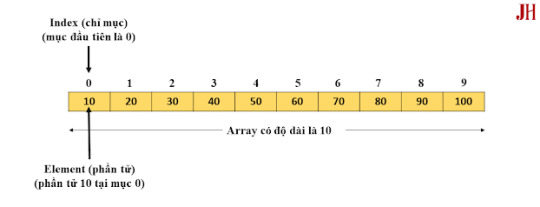
Ảnh mô tả chỉ mục và các phần tử trong một mảng.
Mảng (Array) trong Java là gì?
Mảng trong Java là một tập hợp các phần tử có cùng kiểu dữ liệu, được lưu trữ liên tiếp trong bộ nhớ. Mỗi phần tử trong mảng được truy cập thông qua chỉ số (index), bắt đầu từ 0. Mảng có kích thước cố định, nghĩa là sau khi khởi tạo, bạn không thể thay đổi số lượng phần tử.
Ví dụ, nếu bạn muốn lưu trữ điểm số của 5 học sinh, thay vì tạo 5 biến riêng lẻ, bạn có thể sử dụng một mảng để lưu trữ tất cả trong một biến duy nhất.
Đặc điểm chính của mảng trong Java:
Kiểu dữ liệu đồng nhất: Tất cả phần tử trong mảng phải cùng kiểu (int, String, double, v.v.).
Kích thước cố định: Không thể thay đổi kích thước sau khi khởi tạo.
Truy cập nhanh: Nhờ chỉ số, việc truy cập phần tử trong mảng rất nhanh.
Cách khai báo và khởi tạo mảng trong Java
1. Khai báo mảng
Để sử dụng mảng trong Java, bạn cần khai báo trước. Cú pháp khai báo như sau:kiểu_dữ_liệu[] tên_mảng;
Ví dụ: int[] numbers; // Khai báo mảng số nguyên String[] names; // Khai báo mảng chuỗi
2. Khởi tạo mảng
Sau khi khai báo, bạn cần khởi tạo mảng với kích thước cụ thể hoặc gán giá trị trực tiếp.
Khởi tạo với kích thước: numbers = new int[5]; // Mảng 5 phần tử, mặc định giá trị là 0
Khởi tạo với giá trị: int[] numbers = {10, 20, 30, 40, 50};
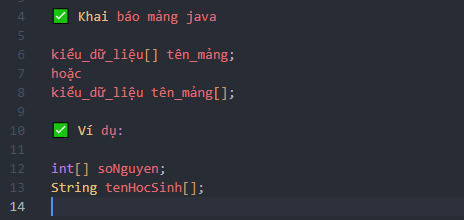
Minh họa cú pháp khai báo và khởi tạo mảng
Cách truy cập và thao tác với mảng
1. Truy cập phần tử mảng
Mỗi phần tử trong mảng được truy cập thông qua chỉ số (index). Ví dụ: int[] numbers = {10, 20, 30, 40, 50}; System.out.println(numbers[0]); // In ra 10 System.out.println(numbers[2]); // In ra 30
2. Thay đổi giá trị phần tử
Bạn có thể gán giá trị mới cho phần tử trong mảng bằng cách sử dụng chỉ số: numbers[1] = 25; // Thay đổi giá trị tại index 1 thành 25
3. Duyệt mảng
Có nhiều cách để duyệt qua các phần tử của mảng trong Java:
Sử dụng vòng lặp for:
for (int i = 0; i < numbers.length; i++) { System.out.println(numbers[i]); }
Sử dụng vòng lặp for-each:
for (int num : numbers) { System.out.println(num); }
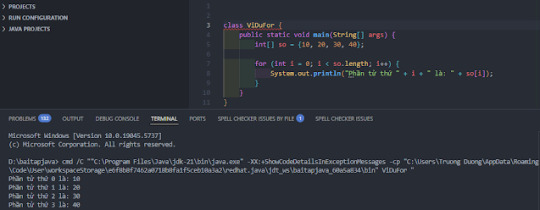
Vòng lặp for truy cập các phần tử trong mảng
Các ví dụ thực tế về mảng trong Java
Ví dụ 1: Tính tổng các phần tử trong mảng
public class SumArray { public static void main(String[] args) { int[] numbers = {10, 20, 30, 40, 50}; int sum = 0; for (int num : numbers) { sum += num; } System.out.println("Tổng các phần tử: " + sum); } }
Kết quả: Tổng các phần tử: 150
Ví dụ 2: Tìm phần tử lớn nhất trong mảng
public class MaxArray { public static void main(String[] args) { int[] numbers = {5, 2, 8, 1, 9}; int max = numbers[0]; for (int i = 1; i < numbers.length; i++) { if (numbers[i] > max) { max = numbers[i]; } } System.out.println("Phần tử lớn nhất: " + max); } }
Kết quả: Phần tử lớn nhất: 9
Một số lưu ý khi sử dụng mảng trong Java
Lỗi ArrayIndexOutOfBoundsException: Xảy ra khi bạn truy cập chỉ số ngoài phạm vi của mảng. Ví dụ: truy cập numbers[5] trong mảng có kích thước 5 sẽ gây lỗi.
Kích thước cố định: Nếu cần mảng có kích thước động, bạn nên sử dụng ArrayList thay vì mảng.
Hiệu suất: Mảng rất nhanh trong việc truy cập phần tử, nhưng không phù hợp khi cần thêm/xóa phần tử thường xuyên.

Lỗi ArrayIndexOutOfBoundsException
Mảng đa chiều trong Java
Mảng không chỉ giới hạn ở một chiều. Mảng đa chiều (2D, 3D,...) thường được sử dụng để biểu diễn ma trận hoặc bảng dữ liệu. Ví dụ về mảng 2 chiều: int[][] matrix = { {1, 2, 3}, {4, 5, 6}, {7, 8, 9} }; System.out.println(matrix[1][2]); // In ra 6
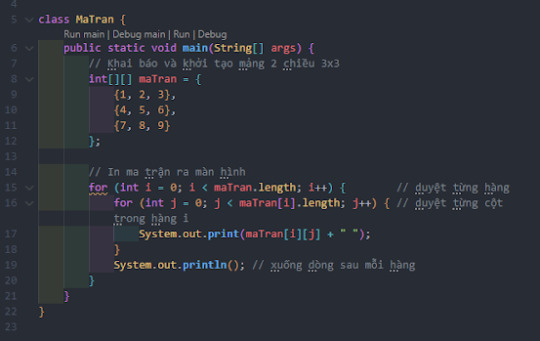
Hình ảnh minh họa mảng 2 chiều
Kết luận
Mảng (Array) trong Java là một công cụ mạnh mẽ để lưu trữ và xử lý dữ liệu. Với cú pháp đơn giản, mảng phù hợp cho nhiều bài toán lập trình, từ cơ bản đến nâng cao. Bằng cách nắm vững cách khai báo, khởi tạo, truy cập và thao tác với mảng, bạn sẽ dễ dàng giải quyết các vấn đề liên quan đến dữ liệu. Hy vọng bài viết này đã cung cấp cho bạn cái nhìn tổng quan và những ví dụ thực tế hữu ích về mảng trong Java.
Nếu bạn muốn tìm hiểu thêm về mảng hoặc các cấu trúc dữ liệu khác trong Java, hãy tiếp tục khám phá và thực hành qua các bài tập thực tế!
🔹 Mảng (Array) Trong Java | Cách Dùng & Ví Dụ Dễ Hiểu Tìm hiểu cách khai báo, truy cập và sử dụng mảng trong Java. Hướng dẫn kèm ví dụ thực tế giúp bạn nắm vững kiến thức nhanh chóng. 🌐 Website: Java Highlight
#JavaHighlight#ArrayTrongJava#JavaArray#LapTrinhJava#JavaTutorial#JavaBasics#JavaLearning#JavaForBeginners#Javacoban#JRE#Mảng trong java#mang trong java
0 notes
Text
Binary Search in Java (Made Super Simple)
Hey folks!
If you're new to programming or just getting started with Java, you might’ve come across the term Binary Search. It might sound a little intimidating at first, but trust me, once you get the hang of it, it’s actually a pretty neat and efficient way to search through data.
Let’s break it down in a super simple way.
Imagine you have a sorted list of numbers — something like [2, 5, 8, 12, 16, 23, 38, 45, 56, 72, 91]. Now, let’s say you want to find out if the number 23 is in that list. You could go one by one, checking each number (this is called linear search), but that would take time — especially if the list is super long.
Enter Binary Search. Instead of checking each number, binary search cuts the list in half, checks the middle value, and then decides whether to go left or right, depending on whether the number you’re looking for is smaller or bigger than the middle value. This continues until the number is found, or until the list can’t be split anymore.
It’s kind of like playing a number guessing game. Say you’re told to guess a number between 1 and 100, and after every guess, you're told whether your guess was too high or too low. Instead of guessing randomly, you’d usually go for the middle, like 50, then adjust based on the feedback. That’s basically how binary search works!
In Java, writing a binary search algorithm is pretty straightforward. It usually involves using a while loop, checking the middle index of the array, and updating the start and end points based on your comparisons. With just a few lines of code, you get a fast and efficient way to search.
If you want a clear and beginner friendly explanation along with the Java code, do check out this page: Binary Search in Java.
It explains the logic step-by-step, and the example makes it easy to follow even if you're just starting out with coding. Practicing small programs like this is a great way to build your confidence and understanding of how algorithms work.
So yeah, binary search isn’t scary at all. Give it a shot, play around with the code, and see how it works in action. Once you get it, you’ll feel pretty good about adding it to your programming toolbox.
1 note
·
View note
Text
"Java in a Nutshell" by Benjamin J. Evans and David Flanagan is a concise yet comprehensive guide to the Java programming language. It serves as both a tutorial for beginners and a reference for experienced developers. The book covers the core features of Java, along with advanced topics, making it a valuable resource for anyone looking to master Java. Below is a user-friendly, step-by-step breakdown of the key outcomes and takeaways from the book, designed to help readers understand and apply Java effectively.
#Java#JavaProgramming#JavaInANutshell#JavaDevelopment#SoftwareDevelopment#ProgrammingBooks#JavaTutorial#JavaCode#TechBooks#JavaResources#JavaGuide#JavaBestPractices#JavaBasics#TechEducation#ProgrammingLanguages#JavaLearning#Java3#SoftwareEngineering#JavaProjects#JavaTips#JavaJVM#Coding#TechTutorial#JavaCommunity#JavaDevelopmentTools
0 notes
Text
Java vs Kotlin in 2025: Is Java Still Worth Learning?
In a world charmed by shiny tools and swift transitions, dismissing what came before is easy. The tech landscape is always humming—louder than it ever did. And in that rush, Java, the stalwart, gets nudged into the wings as Kotlin walks center stage.

But in 2025, something quiet is happening—Java remains. And not just remains, but serves.
Let’s anchor this in something real: Core Java Training in KPHB is still in demand, still shaping the futures of developers, still grounding newcomers in the fundamentals of software craftsmanship. In this hub of learning, what’s being taught isn't obsolete—it's foundational.
Why Java Holds Ground
Java offers something that doesn't waver with trends: stability. It’s the kind of language that helps you understand the spine of programming logic. And in today’s ecosystem—where microservices, cloud, and data-heavy applications thrive—Java continues to power robust backends, massive systems, and enterprise solutions.
Kotlin, though elegant and concise, leans heavily on Java's shoulders. Without Java, Kotlin wouldn’t stand as tall. It complements, yes. But it does not replace.
The KPHB Perspective
In KPHB, a locality brimming with institutes, tech aspirations, and the rhythms of ambitious learners, Java is more than a language. It’s a rite of passage. Core Java Training in KPHB is not about resisting change—it’s about beginning at the root.
Think of it this way: a tree doesn’t shed its roots just because it’s grown new leaves.
Why Employers Still Respect Java
Look through the job boards in Hyderabad, and you'll see something telling: Java is still there. Required. Expected. Especially in companies where legacy systems coexist with modern frameworks. If you're job-ready in Java, you're already ahead in versatility.
Java is also the first language for many global certification paths. Oracle’s ecosystem, Spring Framework, Android—these remain deeply connected to Java.
What Learners Say
The learners walking through the doors of KPHB’s training centers aren’t chasing trends. They’re seeking direction. They often start with a question: "Should I learn Kotlin instead?" But by the end of their Core Java modules, they understand that this isn’t a choice between old and new—it’s about building a base before climbing.
Looking Ahead
The future doesn't cancel the past. It includes it. Kotlin will continue to rise, especially in Android development and cross-platform spaces. But Java’s rhythm won’t fade—it will deepen.
If you’re in KPHB, wondering where to begin—know this: Core Java Training in KPHB isn’t just a course. It’s a compass.
🧠 Previous Year Questions - Core Java
1. What is the difference between JDK, JRE, and JVM? Answer:
JDK (Java Development Kit) is a software development kit used to develop Java applications.
JRE (Java Runtime Environment) provides the environment to run Java applications.
JVM (Java Virtual Machine) executes Java bytecode and provides platform independence.
2. Explain the concept of inheritance in Java. Answer: Inheritance is an OOP concept where one class (child) acquires properties and behavior from another class (parent) using the extends keyword. It promotes code reusability.
3. What is the difference between method overloading and method overriding? Answer:
Overloading occurs within the same class with different parameter lists.
Overriding occurs in a subclass, redefining a superclass method with the same signature.
4. What are access specifiers in Java? Answer: Access specifiers define the scope of access:
private – within the class only
default – within the same package
protected – within the same package or subclasses
public – accessible from everywhere
5. Explain the use of the ‘final’ keyword. Answer: The final keyword is used to declare constants, prevent method overriding, and prevent inheritance of classes.
6. What is the difference between an abstract class and an interface? Answer:
Abstract class can have both abstract and non-abstract methods; supports constructors.
Interface contains only abstract methods (prior to Java 8) and multiple inheritance of type.
7. What is multithreading in Java? Answer: Multithreading allows concurrent execution of two or more parts of a program for maximum CPU utilization using the Thread class or Runnable interface.
8. What is garbage collection in Java? Answer: Garbage collection is the process of automatically reclaiming memory by destroying unused objects to free space.
9. How does exception handling work in Java? Answer: It uses five keywords: try, catch, throw, throws, and finally to handle run-time errors, improving program stability.
10. What is the use of the ‘this’ keyword? Answer: The this keyword refers to the current object of a class, often used to distinguish between instance and local variables.
#CoreJava#JavaTraining#JavaInterviewQuestions#JavaBasics#KPHBTraining#JavaForBeginners#JavaLearning#JavaDevelopment#JavaCertification#JavaConcepts#KPHBJava#JavaClassesHyderabad#SoftwareTraining#TechSkillsIndia#JavaPYQs
0 notes
Text
Understanding the Java Equals Method: String Comparison Made Easy
Understand the Java Equals Method and its role in comparing object equality in Java programming. Learn how to effectively use equals for precise comparisons between Java objects.
0 notes
Video
youtube
How to remove a sublist from a list in java | java inspires
0 notes
Text
Core Java training near me
Embark on a journey of Java excellence with Sunbeam Institute for Java Training. Our comprehensive Core Java training program is designed to equip you with the essential skills to become a proficient Java developer. Whether you're a beginner or looking to level up your Java expertise, we've got you covered.
Why Choose Sunbeam Institute for Java Training?
✨ Expert Instructors: Learn from seasoned Java developers and industry experts with years of practical experience.
✨ Hands-on Learning: Dive into the world of Java through hands-on projects and real-world applications.
✨ Personalized Attention: Benefit from small class sizes and personalized attention to ensure a conducive learning environment.
✨ Updated Curriculum: Stay ahead in the Java landscape with a curriculum that covers the latest advancements and best practices.
#CoreJava#JavaTraining#JavaDevelopment#ProgrammingEducation#LearnJava#CodeWithJava#JavaProgramming#JavaClasses#TechTraining#JavaSkills#JavaBootcamp#CodingInstitute#JavaBasics#ProgrammingSkills#JavaLearning#ObjectOrientedProgramming#JDBC#JavaAPIs#CodingJourney#TechCareer
0 notes
Text
Introduction to Java Programming: Basics
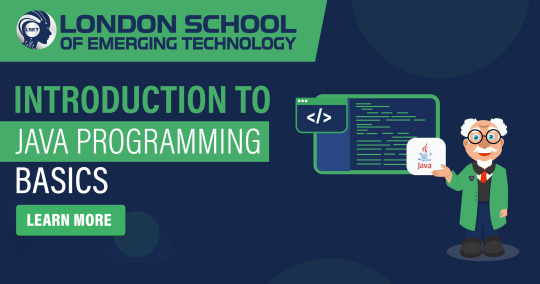
Embarking on Your Java Journey: Introduction to Java Programming Basics. Delve into the world of Java programming and lay a solid foundation in the basics of Java. LSET comprehensive guide covers essential topics such as syntax, data types, control structures, and object-oriented programming principles, providing a strong starting point for beginners. Plus, with London School of Emerging Technology (LSET) Java Programming Course, you'll receive expert-led instruction and hands-on experience to master Java programming from beginner to advanced levels. Join us and unlock the potential of Java, equipping yourself with the skills to develop robust and scalable software applications.
Enrol @ https://lset.uk/ for admission.
0 notes
Text
0 notes
Text
➗ Day 10 of Java Mastery: Arithmetic Operators in Java Let’s talk math in Java! 🧠 Arithmetic operators help you perform basic mathematical operations. Read Blog: https://wp.me/paNbWh-68 #Java #JavaMastery #Day10 #ArithmeticOperators #LearnJava #100DaysOfCode #CodeNewbie #JavaBasics
#addition#app development#architectute#arithmetic#backend#beginner#calculations#datastructures#division#execution flow#frontend#fullstack#fullstackdeveloper#minus#multiplication#operators#output#plus#print#substraction
0 notes
Text
Phương Thức trong Java - Hướng dẫn chi tiết
Phương thức trong Java là một thành phần quan trọng trong lập trình hướng đối tượng, giúp tổ chức mã nguồn hiệu quả và tái sử dụng dễ dàng. Trong bài viết này, chúng ta sẽ tìm hiểu chi tiết về phương thức trong Java, cách khai báo, các loại phương thức, và cách sử dụng chúng trong lập trình.

Ảnh mô tả hai phương thức chính trong java
Phương thức trong Java là gì?
Phương thức trong Java là một khối mã thực hiện một nhiệm vụ cụ thể và được định nghĩa bên trong một lớp. Phương thức thường được sử dụng để thực hiện các hành động như tính toán, xử lý dữ liệu, hoặc điều khiển luồng chương trình. Một phương thức có thể được gọi nhiều lần từ các phần khác nhau trong chương trình, giúp giảm thiểu việc lặp lại mã.
Ví dụ, một phương thức đơn giản để tính tổng hai số trong Java có thể trông như sau:
public int tinhTong(int a, int b) {
return a + b;
}
Trong đoạn mã trên:
public: Quyền truy cập của phương thức.
int: Kiểu dữ liệu trả về.
tinhTong: Tên phương thức.
(int a, int b): Tham số đầu vào.
return a + b: Giá trị trả về.
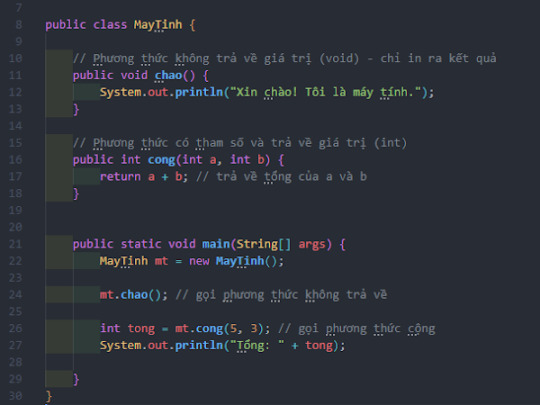
Minh họa cách định nghĩa phương thức trong Java
Cấu trúc của Phương thức trong Java
Một phương thức trong Java có cấu trúc cơ bản như sau:[quyền_truy_cập] [kiểu_trả_về] tên_phương_thức (danh_sách_tham_số) {
// Thân phương thức
}
Các thành phần chính:
Quyền truy cập: Quy định phạm vi sử dụng của phương thức, ví dụ: public, private, protected.
Kiểu trả về: Kiểu dữ liệu mà phương thức trả về, ví dụ: int, String, hoặc void nếu không trả về gì.
Tên phương thức: Tên gọi ngắn gọn, mô tả chức năng của phương thức.
Danh sách tham số: Các biến được truyền vào phương thức để xử lý.
Thân phương thức: Chứa mã thực thi nhiệm vụ của phương thức.
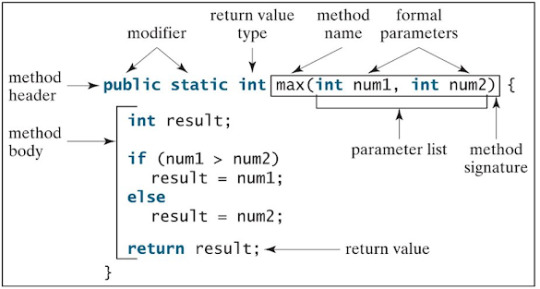
Cấu trúc của phương thức trong Java
Các loại Phương thức trong Java
Có nhiều loại phương thức trong Java, tùy thuộc vào mục đích sử dụng:
1. Phương thức không trả về (void)
Phương thức này không trả về giá trị nào và thường được sử dụng để thực hiện một hành động cụ thể.
Ví dụ:
public void inThongBao() {
System.out.println("Chào mừng bạn đến với Java!");
}
2. Phương thức có trả về
Phương thức này trả về một giá trị cụ thể, sử dụng từ khóa return.
Ví dụ:
public double tinhDienTichHinhTron(double banKinh) {
return 3.14 * banKinh * banKinh;
}
3. Phương thức tĩnh (static)
Phương thức static thuộc về lớp, không cần tạo đối tượng để gọi.
Ví dụ:
public static int tinhGiaiThua(int n) {
if (n == 0) return 1;
return n * tinhGiaiThua(n - 1);
}
4. Phương thức trừu tượng (abstract)
Phương thức này được khai báo trong lớp trừu tượng và không có thân phương thức. Lớp con phải triển khai lại.
Ví dụ:
public abstract void veHinh();
Cách khai báo và sử dụng Phương thức trong Java
Khai báo phương thức
Khi khai báo phương thức trong Java, bạn cần tuân theo cú pháp chuẩn và đặt tên phương thức theo quy ước camelCase.
Ví dụ:
public void hienThiTen(String ten) {
System.out.println("Tên của bạn là: " + ten);
}
Gọi phương thức
Để gọi một phương thức, bạn cần sử dụng tên phương thức và truyền các tham số (nếu có).
Ví dụ:
public class Main {
public static void main(String[] args) {
Main obj = new Main();
obj.hienThiTen("Nguyễn Văn A");
}
public void hienThiTen(String ten) {
System.out.println("Tên của bạn là: " + ten);
}
}
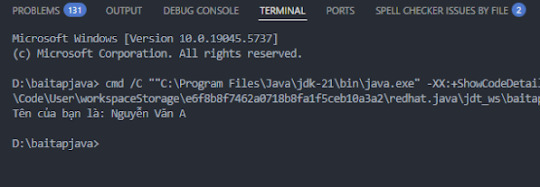
Minh họa kết quả thực tế
Lợi ích của việc sử dụng Phương thức trong Java
Sử dụng phương thức trong Java mang lại nhiều lợi ích:
Tái sử dụng mã: Một phương thức có thể được gọi nhiều lần mà không cần viết lại mã.
Tổ chức mã tốt hơn: Các phương thức giúp chia nhỏ chương trình thành các khối chức năng riêng biệt.
Dễ bảo trì: Việc sửa đổi một phương thức không ảnh hưởng đến các phần khác của chương trình.
Tăng tính trừu tượng: Phương thức giúp ẩn chi tiết triển khai, chỉ hiển thị chức năng cần thiết.
Một số lưu ý khi sử dụng Phương thức trong Java
Đặt tên rõ ràng: Tên phương thức nên mô tả chính xác chức năng, ví dụ: tinhTong thay vì tong.
Hạn chế tham số: Quá nhiều tham số có thể làm phương thức khó hiểu. Nếu cần, hãy sử dụng đối tượng hoặc mảng.
Kiểm tra giá trị trả về: Đảm bảo phương thức trả về đúng kiểu dữ liệu được khai báo.
Xử lý ngoại lệ: Sử dụng try-catch để xử lý các trường hợp lỗi trong phương thức.
Ví dụ xử lý ngoại lệ:
public int chiaHaiSo(int a, int b) {
try {
return a / b;
} catch (ArithmeticException e) {
System.out.println("Lỗi: Không thể chia cho 0");
return 0;
}
}

Minh họa cách phương thức xử lý lỗi
Kết luận
Phương thức trong Java là một công cụ mạnh mẽ giúp lập trình viên tổ chức mã nguồn, tăng tính tái sử dụng và dễ dàng bảo trì. Bằng cách hiểu rõ cách khai báo, sử dụng và các loại phương thức trong Java, bạn có thể viết mã hiệu quả và chuyên nghiệp hơn. Hy vọng bài viết này đã cung cấp cho bạn cái nhìn toàn diện về phương thức trong Java và cách áp dụng chúng trong lập trình.
Nếu bạn muốn tìm hiểu thêm về các chủ đề lập trình Java khác, hãy tiếp tục theo dõi các bài viết của chúng tôi!
Phương Thức Trong Java – Hướng Dẫn Chi Tiết Cho Người Mới Bắt Đầu Tìm hiểu cách khai báo, gọi phương thức, phân biệt return và void, cùng các ví dụ minh họa rõ ràng. 🌐 Website: Java Highlight #JavaHighlight #JavaMethod #PhuongThucJava #JavaTutorial #LapTrinhJava #JavaBasics #JavaLearning #JavaProgramming #OOPJava #JavaForBeginners
#java highlight#JavaMethod#JavaHighlight#PhuongThucJava#JavaTutorial#LapTrinhJava#JavaBasics#JavaLearning#JavaProgramming#OOPJava#JavaForBeginners#Phương Thức trong Java
0 notes
Text
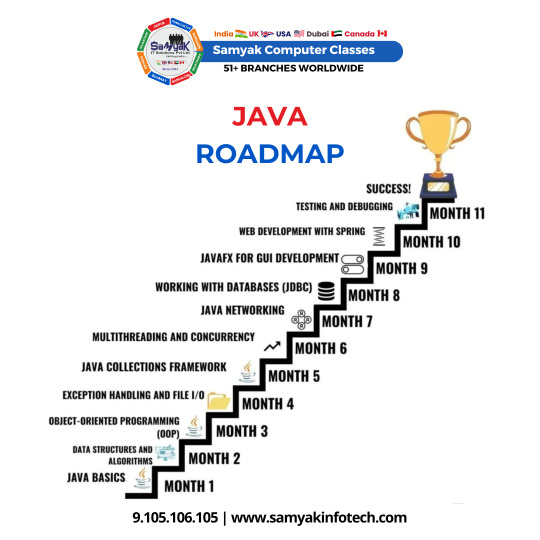
Roadmap to become successful in Java. See how you can master Java in a single year.
Build your career in Java: A Clear Path to Success in Programming.
#Java #Javascript #javacollection #javafx #javabasic #Webdevelopment #samyak #samyakcomputerclasses #javascripts #javaprogramming #javadeveloper
0 notes